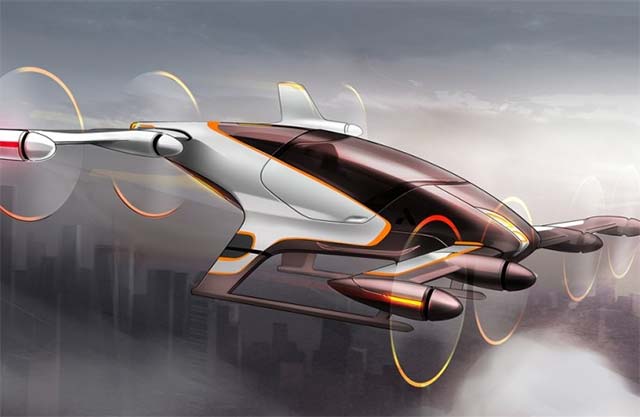Bosch introduces sensor boxes designed for unmanned 'flying taxis'
The taxi drone is no longer the only thing found in stories, sci-fi films, but will come to the real world, serving the modern life of people. According to Boston Consulting Group Consulting Group, by 2030, there will be more than 1 billion fixed journeys successfully implemented by unmanned drones around the world. In particular, not only are the freight transshipments, these 'flying taxis' can also become people with a high level of safety, all of which will be fully automated, without any help. of the pilot. To reinforce this identity, today, Bosch - one of the world's largest technology corporations - has officially introduced a new sensor box designed for small civil aviation vehicles. , according to the description is the plug-and-play medium.
 Bosch introduces sensor boxes designed for unmanned 'flying taxis' Picture 1
Bosch introduces sensor boxes designed for unmanned 'flying taxis' Picture 1
- Contemplating the performance of the drone model has a tremendous 'evasion index'
The sensor will include electromechanical microphones - also known as MEMS - accelerometer sensors that record all information about every movement of the vehicle, combined with some sensors. Super-fast speeds are built-in, helping to track devices by dynamics flying in 3D space, limiting collisions from all angles. In addition, magnetic sensors will measure the compass navigation index, while pressure sensors are responsible for measuring altitude from atmospheric pressure, thereby determining the current speed of vehicle.
According to Bosch, the top advantage of new sensor boxes compared to conventional solutions is that it is lighter and more compact, which saves considerable space, so that it can be easily integrated on flying vehicles. compact. This compactness is partly achieved by products that use some of the same sensors found in automatic driving systems and ESP antiskid systems developed by Bosch.
 Bosch introduces sensor boxes designed for unmanned 'flying taxis' Picture 2
Bosch introduces sensor boxes designed for unmanned 'flying taxis' Picture 2
- Transportation businesses use unmanned aircraft to provide medical supplies in the United States
'Through the Bosch solution, we want to aim for the civil aviation taxi service to become a reality soon, affordable, operated by many service providers and it is important to ensure be safe. Compared to the current road transport vehicle, flying taxis, if put into operation, can significantly save time on each trip, and are especially capable of operating within a maximum radius of nearly 300km. . Currently, we are strengthening cooperation with manufacturers in the aerospace and automotive industry, as well as with start-up companies to create unmanned aerial vehicles to find a sensory integration solution. Optimal as well as developing related technologies. Besides, Bosch is also looking to provide media sharing services. The question here is no longer whether flying taxis will become a reality, but when these vehicles will actually be applied in life, 'said Bosch Group Senior Director Mr. Marcus Parentis. , share.
Mr. Marcus Parentis' optimistic and overconfident optimism is not unfounded. Experts predict that aviation taxis will start taking seriously in the transportation sector within just 3 years, and these taxis can start to fly automatically or semi-automatically on early 2025.
 Bosch introduces sensor boxes designed for unmanned 'flying taxis' Picture 3
Bosch introduces sensor boxes designed for unmanned 'flying taxis' Picture 3
- Memorize with the world record set of 1,374 unmanned aircraft
Roland Berger industry leading analysts predict that there will be more than 3,000 taxis operating worldwide in the next 5 years. Not only that, analysts also believe that this number will be able to increase to over 12,000 by 2030, and even to nearly 100,000 vehicles by 2050.
Meanwhile, investment bank, US stock market Morgan Stanley expects that the taxi market can reach up to 1.5 trillion dollars by 2040. Thus, the transport and technology corporations Transportation seems to be interested in this new field as well as the benefits it brings are completely understandable.
Just last week, Germany's Lilium Jet start-up airline completed the first test of its compact 5-seater model. In addition, another large enterprise, Chinese electronics group Ehang also plans to build a four-propeller fleet of passenger aircraft in the next few years.
The co-founder of Google, Larry Page, has received support from the New Zealand government for a test drive plan as well as trying to take off and landing (VTOL) for his flying taxi model with the help of Drone management software Kittyhawk. While Volocopter's 18-propeller passenger drone model has recently successfully completed test flights through Dubai, the ambition is to make the manufacturer a pioneer in the taxi drone sector. unmanned in the world.
 Bosch introduces sensor boxes designed for unmanned 'flying taxis' Picture 4
Bosch introduces sensor boxes designed for unmanned 'flying taxis' Picture 4
- Malaysia will launch its flying car model this year?
In addition, flying taxis come from big names in the aerospace industry like AeroMobil, Vertical Aeorospace, Joby Aviation, Airbus, Boeing, and Bell are also in various stages of development and will soon be is put to the test. There are more than 100 such electric 'aircraft' projects being developed worldwide. Bosch expects unmanned test flights to be boosted in cities like Los Angeles, Dallas and Singapore next year.
'Bosch plans to become a leading role in shaping this potential future market,' said Bosch automotive electronics president Harald Kröger.
You should read it
- Toyota is betting on the ambition to conquer the sky on an emerging taxi manufacturer
- Uber has set a time to launch taxi service
- This drone can identify anyone with a fever and cough
- List of phone numbers of taxi firms in Hanoi
- Contemplating the performance of the drone model has a tremendous 'evasion index'
- How to call Mai Linh taxi on the phone
- What is a UAV (drone), how does one control it and what can it be used for?
- How to Start a Taxi Company
- Amazon patents a drone self-destruct in an emergency
- Transportation businesses use unmanned aircraft to provide medical supplies in the United States
- How to order a taxi by Zalo on the phone
- Instructions for registering and using Uber Taxi
May be interested

Mozilla released Firefox Send - a free encrypted file sharing service

Apple Music is now available on Amazon Fire TV

Leaking images of new patents by Google: Challenges of the folding screen market in the future?

Razer launches a new, cool 'new' collection of gaming accessories but traditionally cheaper

Japan introduced assistant robots for the Olympics 2020

The Shenzhen city subway system will allow payment through face recognition feature






 The world's first airport for unmanned aerial vehicles is about to start
The world's first airport for unmanned aerial vehicles is about to start Wingless animals that can fly like birds
Wingless animals that can fly like birds 7 common error codes on Bosch dishwashers and how to fix them
7 common error codes on Bosch dishwashers and how to fix them Instructions on how to use the dishwasher Bosch SMS25KI00E
Instructions on how to use the dishwasher Bosch SMS25KI00E Top dishwasher Bosch serie 2, series 4, series 6 are the most popular today
Top dishwasher Bosch serie 2, series 4, series 6 are the most popular today Looking back on the achievements after 60 years of human conquest of the universe
Looking back on the achievements after 60 years of human conquest of the universe